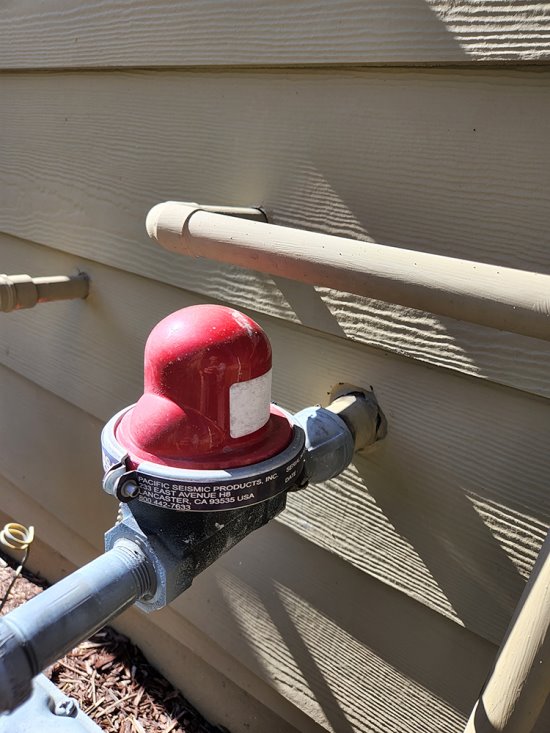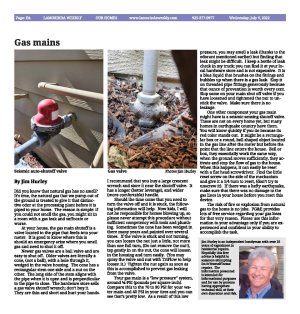| | Published July 6th, 2022
| Gas mains
| | | By Jim Hurley |  | | Seismic auto-shutoff valve |
Did you know that natural gas has no smell? It's true, the natural gas that we pump out of the ground is treated to give it that distinctive odor at the processing plant before it is piped to your home. The reason is simple: if you could not smell the gas, you might sit in a room with a gas leak and suffocate or worse.
 At your house, the gas main shutoff is a valve located in the pipe that feeds into your meter. It is good to know where this is should an emergency arise where you smell gas and need to shut it off.
At your house, the gas main shutoff is a valve located in the pipe that feeds into your meter. It is good to know where this is should an emergency arise where you smell gas and need to shut it off.
 Newer gas valves are a ball valve and are easy to shut off. Older valves are literally a cone, (not a ball), with a hole through it, wedged in the valve housing. The cone has a rectangular stem one side and a nut on the other. The long side of the stem aligns with the pipe when it is open and is perpendicular to the pipe to close. The hardware store sells a gas valve shutoff wrench; don't buy it. They are thin and short and hurt your hands. I recommend that you buy a large crescent wrench and store it near the shutoff valve. It has a longer (better leverage), and wider (more comfortable) handle.
Newer gas valves are a ball valve and are easy to shut off. Older valves are literally a cone, (not a ball), with a hole through it, wedged in the valve housing. The cone has a rectangular stem one side and a nut on the other. The long side of the stem aligns with the pipe when it is open and is perpendicular to the pipe to close. The hardware store sells a gas valve shutoff wrench; don't buy it. They are thin and short and hurt your hands. I recommend that you buy a large crescent wrench and store it near the shutoff valve. It has a longer (better leverage), and wider (more comfortable) handle.
 Should the time come that you need to turn the valve off and it is stuck, the following information will help. Now kids, I will not be responsible for homes blowing up, so please never attempt this procedure without sufficient competency with tools and plumbing. Sometimes the cone has been wedged in there many years and painted over several times. If the valve is stuck and not turning, you can loosen the nut just a little, not more than one full turn, (Do not remove the nut!), tap gently in on the nut, the cone will loosen in the housing and turn easily. (You may spray the valve and nut with TriFlow to help loosen it.) Tighten the nut again as soon as this is accomplished to prevent gas leaking from the valve.
Should the time come that you need to turn the valve off and it is stuck, the following information will help. Now kids, I will not be responsible for homes blowing up, so please never attempt this procedure without sufficient competency with tools and plumbing. Sometimes the cone has been wedged in there many years and painted over several times. If the valve is stuck and not turning, you can loosen the nut just a little, not more than one full turn, (Do not remove the nut!), tap gently in on the nut, the cone will loosen in the housing and turn easily. (You may spray the valve and nut with TriFlow to help loosen it.) Tighten the nut again as soon as this is accomplished to prevent gas leaking from the valve.
 Your gas main is a "low pressure" system, around 1/4-PSI (pounds per square inch). Compare this to the 70 to 90 PSI for your water main and 40 PSI in your tires and you can see that's pretty low. As a result of this low pressure, you may smell a leak (thanks to the odorant mentioned earlier) but finding that leak might be difficult. I keep a bottle of leak check in my truck; you can find it at your local hardware store and is not expensive. It is a blue liquid that brushes on the fittings and bubbles up when there is a gas leak. Slop it on threaded pipe fittings generously because that ounce of prevention is worth every cent. Slop some on your main shut off valve if you have loosened and tightened the nut to unstick the valve. Make sure there is no leakage.
Your gas main is a "low pressure" system, around 1/4-PSI (pounds per square inch). Compare this to the 70 to 90 PSI for your water main and 40 PSI in your tires and you can see that's pretty low. As a result of this low pressure, you may smell a leak (thanks to the odorant mentioned earlier) but finding that leak might be difficult. I keep a bottle of leak check in my truck; you can find it at your local hardware store and is not expensive. It is a blue liquid that brushes on the fittings and bubbles up when there is a gas leak. Slop it on threaded pipe fittings generously because that ounce of prevention is worth every cent. Slop some on your main shut off valve if you have loosened and tightened the nut to unstick the valve. Make sure there is no leakage.
 One other component your gas main might have is a seismic sensing shutoff valve. These are not on every home yet, but many homes in earthquake country have them. You will know quickly if you do because its red color stands out. It might be a rectangular box or a round, bell shaped object located in the gas line after the meter but before the point that the line enters the house. Bell or box, they essentially work the same way, when the ground moves sufficiently, they activate and stop the flow of gas to the house. When this happens, it can easily be reset with a flat head screwdriver. Find the little reset screw on the side of the mechanism and give it a 1/4 turn to reset, (don't try to unscrew it). If there was a hefty earthquake, make sure that there was no damage to the gas lines in your house before you reset this device.
One other component your gas main might have is a seismic sensing shutoff valve. These are not on every home yet, but many homes in earthquake country have them. You will know quickly if you do because its red color stands out. It might be a rectangular box or a round, bell shaped object located in the gas line after the meter but before the point that the line enters the house. Bell or box, they essentially work the same way, when the ground moves sufficiently, they activate and stop the flow of gas to the house. When this happens, it can easily be reset with a flat head screwdriver. Find the little reset screw on the side of the mechanism and give it a 1/4 turn to reset, (don't try to unscrew it). If there was a hefty earthquake, make sure that there was no damage to the gas lines in your house before you reset this device.
 The risk of fire or explosion from natural gas to the home is no joke. PG&E provides lots of free service regarding your gas lines for that very reason. Please use this information to your advantage only if you are experienced and confident in your ability to accomplish the task.
The risk of fire or explosion from natural gas to the home is no joke. PG&E provides lots of free service regarding your gas lines for that very reason. Please use this information to your advantage only if you are experienced and confident in your ability to accomplish the task. |
 | | Gas valve Photos Jim Hurley |  | | Jim Hurley is an independent handyman with over 25 years of experience in residential repairs. Hopefully this free advice is helpful to someone attempting Do-It-Yourself home repairs. The information presented is intended for informational purposes and for use by persons having appropriate technical skill, at their own discretion and risk. | | | | | | | | | |





